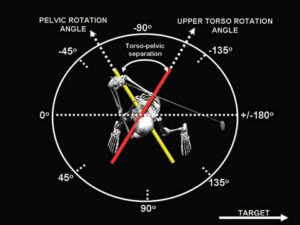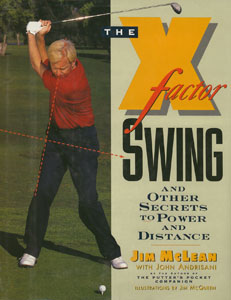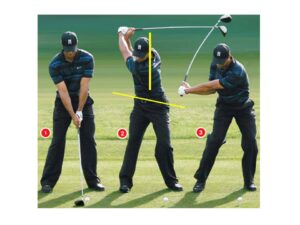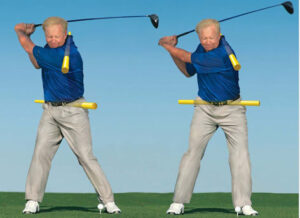The X-factor Series (1 of 3)
The following is the first of a series of posts about the X-factor, X-factor stretch and how it relates to the golf swing. The series will cover:
-
1st: What the X-factor and X-factor stretch are and Is the X-factor stretch more important than the X-factor?
- 2nd: What makes the X-factor stretch important for distance in the golf swing?
- 3rd: Is the X-factor safe for your body and back, and what you can do to improve it. For those of you with bad backs, increasing the X-factor might not be for you. However I will give you some tips to make the most the most out of your body.
X-factor is a term first introduced by John Andrisani of golf digest and made popular by Jim McLean in the article, “Widen the Gap” in 1992. They later wrote a book on it in 1997, and I would recommend it any teacher or student of the game. I’ve seen them for $1 online. Basically the X-factor is the difference between the upper body (shoulder turn) and the lower body (pelvic or hip turn) turn at the top of the backswing.
For example, a 90 degree should turn and a 50 degree hip turn would equal a 40 degree X-factor.
I.e. 90 – 50 = 40 degree X-factor

Teaching professionals may recognize this as “coil” and TPI professionals may recognize this as “spinal rotation” (Cheetham 2013). Preliminary research by McTeigue in 1994 concluded that the long hitting professionals had more coil or spinal rotation than the rest of the professionals. It was thought that the bigger the X-factor, the further you could hit the ball.
What McTeigue also reported was 70% of professionals rotated their hips first on the downswing. Two things can be drawn from this:
One. This is what is referred to as X-factor stretch by Phil Cheetham. The X-factor stretch is the increase in the X-factor at the beginning of the downswing. This is produced by starting the downswing with the hips, while maintaining a still upper body.
- Let’s use the same example with the 40 degree X-factor. So now, the downswing is started by rotating the hips towards the target, while maintaining the same upper body rotation. Moving the hips towards the target increases the angle between the hips and the shoulders.
- Right before the upper body starts the downswing, the difference is now the X-factor stretch. Let’s say the hip rotation is 45. With the same upper body rotation of 90, the new X-factor is 45 degrees. Or, in other words the X-factor stretch is 5 degrees.
- Interestingly, what Cheetham found in his research is that the X-factor stretch was significantly larger in higher skilled golfers than less, while the X-factor was similar. He concluded the X-factor stretch is more important than the X-factor itself (Cheetham 2013). The TPI tour average for X-factor at the top of the backswing is 42 degrees and the average tour X-factor stretch is 5 degrees.
Two. TPI refers to the X-factor stretch as “Downswing Loading.” Further analysis by TPI has shown that the key to consistency in the golf swing is having proper kinematic sequence. TPI’s philosophy is as stated,
“We do not believe there is one way to swing the club; we believe there are an infinite number of ways to swing a club. But we do believe that there is one efficient way for everyone to swing a club and it is based on what they can physically do.”
- Basically they are saying all efficient swings have something in common. What that something is, is kinematic sequence. TPI has discovered that under 3D biomechanics Adam Scott’s or Ernie Els’ swing both are identical to Jim Furyk. Obviously they look way different and you wouldn’t think these 3 swings have anything in common.
- The proper kinematic sequence for the downswing should be hips, torso, arm and then wrist and club in that exact order. This order allows the golfer to be constant and produce the most club head speed.
Here’s a great example of Jim McLean explaining the X-factor with Peter Jacobsen.
In summary:
- The X-factor is the difference between the rotation of the pelvis and the shoulders at the top of the backswing. The tour average is 40 degrees.
- The X-factor stretch is the difference in the X-factor created at the beginning of the downswing, when the pelvis starts to rotate towards the target with the upper body being still. The tour average for the X-factor is 5 degrees.
- The X-factor stretch is more important than the X-factor because professionals have more X-factor Stretch than amateurs. This allows them to produce more distance.
- The most efficient professionals have the same kinematic sequence of the downswing.
- Pelvis rotation>torso rotation>shoulder rotation>club
- The proper kinematic sequence is needed for consistency and distance.
The next (2 of 3) X-factor series article will cover what makes the X-factor stretch more important than the X-factor.
The last of the series will cover is the X-factor stretch good for your body, and if you have back pain what can you do instead of the X-factor. I will give you some tips and exercise you can do to try to increase this X-factor stretch!
Sources:
Jim McLean. Widen the Gap, Golf Digest. 1992
Cheetham. The difference between the X-factor and X-factor stretch. 2013
McTeigue. Spine and hip motion analysis during the golf swing. 1994





